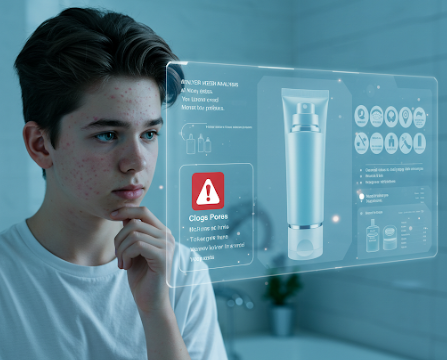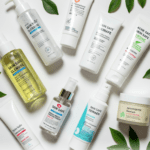Although many skincare items are labeled as “non-comedogenic” or “acne safe,” these terms are often unregulated and vary between brands. If you have acne-prone skin, you might have asked yourself at some point: what are pore clogging ingredients?
Knowing which ingredients clog pores can save you weeks of frustration and can give you the tools to build a customized routine that works with, not against, your skin. A recent study indicated that nearly 85% of adolescents and young adults face acne problems, and many of these breakouts can result from using products containing pore-clogging substances.
What Is an Acne Ingredient Checker?
An acne ingredient checker is an online tool or database where you paste or type in a full product ingredient list, and it highlights which ingredients may clog pores (comedogenic) or irritate your skin. These checkers help decode confusing labels and give you a clearer picture of what may be causing acne breakouts.
How Does It Work?
- Copy the Ingredient List: Find the complete list on the product’s packaging or website.
- Paste into the Checker: Insert the list into the online tool.
- Review the Results: The checker flags ingredients known for pore clogging, irritation, or potential acne risk.
The tool considers various factors, such as ingredient concentration and known comedogenic ratings from research studies. Although the process is straightforward, remember that results can vary based on skin type. What clogs pores for one person might be safe for another.
Why Use an Acne Ingredient Checker?
Even products that claim to be “non-comedogenic” may include ingredients that trigger acne. Labels can be misleading since there is little regulatory oversight of terms like “acne-safe” or “non-comedogenic.”
Using a trusted ingredient checker helps you take control of your skincare routine, ensuring you avoid substances that can lead to breakouts.
Key Benefits:
- Clarity: You gain a clear breakdown of your product’s ingredients.
- Control: Identify which ingredients might be causing YOUR specific skin issues.
- Confidence: Build a skincare regimen that works with your skin’s needs rather than against them.
“When the skin is dehydrated, it can overproduce oil to compensate, which can lead to clogged and more prominent pores.”
This emphasizes the importance of knowing what’s in your products and ensuring they support hydration without causing congestion.
Moreover, checkers can also point out common culprits, like isopropyl myristate and coconut oil, which are well-known for their high comedogenic ratings.
High Comedogenic Ingredients (Ratings 4–5)
| Ingredient | Comedogenic Rating | Notes |
|---|---|---|
| Coconut Oil | 4–5 | A widely used moisturizer, but its heavy texture may clog pores. |
| Isopropyl Myristate | 5 | Often used for a silky feel; tends to block pores in many cases. |
| Myristyl Myristate | 4–5 | A thick emollient with high occlusive properties. |
| Laureth-4 | 4 | Commonly found in surfactant systems; can contribute to pore blockage. |
| Cocoa Butter | 4 | Nourishing and occlusive, but heavy enough to clog pores on acne-prone skin. |
| Isopropyl Palmitate | 4 | A conditioning agent that may build up on the skin, increasing blockage risk. |
| Decyl Oleate | 4 | Used to improve product texture, but its occlusivity can block pores. |
| Wheat Germ Oil | 4–5 | Rich in nutrients yet heavy; may lead to breakouts in susceptible skin. |
| Oleic Acid | 5 | A fatty acid that can provide a strong barrier effect, encouraging pore blockage. |
Moderate Comedogenic Ingredients (Ratings 2–3)
| Ingredient | Comedogenic Rating | Notes |
|---|---|---|
| Avocado Oil | 2–3 | Nourishing and rich in fatty acids; may be problematic for some users. |
| Olive Oil | 2–3 | A common ingredient that is generally well-tolerated, but can be slightly occlusive. |
| Sweet Almond Oil | 2 | Lighter than many oils, though it might trigger breakouts in very sensitive skin. |
| Grapeseed Oil | 2 | A lighter oil with a lower incidence of clogging pores for most users. |
| Soybean Oil | 2–3 | Moderately occlusive; used for its emollient properties in many formulas. |
| Jojoba Oil | 2 | Chemically similar to skin sebum; many find it balances oil production, though some sources note a slight risk. |
| Hemp Seed Oil | 2 | Contains a balanced ratio of fatty acids; generally gentle on the skin. |
Low Comedogenic Ingredients (Ratings 0–1)
| Ingredient | Comedogenic Rating | Notes |
|---|---|---|
| Squalane/Squalene | 0 | Lightweight and non-greasy; rarely clogs pores. |
| Mineral Oil | 0 | Inert, though occlusive; many users do not experience acne breakouts from it. |
| Dimethicone | 0 | A silicone derivative that creates a smooth barrier without clogging pores. |
| Rosehip Oil | 1 | Often well-tolerated by acne-prone skin; provides essential fatty acids. |
| Sunflower Oil | 1 | A light oil that rarely causes breakouts in most formulations. |
| Water (and water-based ingredients like glycerin, hyaluronic acid, propylene glycol) | 0 | Used in many formulations; does not contribute to pore clogging. |
The Science Behind Pore Clogging and Acne
To understand how an ingredient can lead to acne, we need to consider the concept of comedogenicity—the likelihood that an ingredient will clog pores and contribute to acne. Even small changes in your skincare routine can tip the balance between clear and breakout-prone skin.
Studies have shown that certain ingredients, when used in high concentrations or in leave-on products, have a much higher comedogenic rating. For example, coconut oil often scores a 4 or 5 on the comedogenic scale, meaning it has a high potential to clog pores and cause acne in some individuals.
A 1989 study by James E. Fulton established a comedogenic scale that rates ingredients on a scale from 0 (non-comedogenic) to 5 (highly comedogenic) 1. However, modern dermatologists note that while the scale provides a guide, real-life reactions can differ based on factors like formulation, concentration, and individual skin type.
“Dermatologists should be used to help clarify what ingredients are considered comedogenic or not.”
This statement serves as a reminder that even with ingredient checkers, professional guidance is invaluable.
Common Ingredients That May Trigger Acne
Many ingredients can contribute to clogged pores and subsequent breakouts. Below is an expanded list with simple explanations on how each might affect your skin:
Table 1. Common Comedogenic Ingredients and Their Ratings
| Ingredient | Comedogenic Rating | Why It Might Cause Acne | Notes |
|---|---|---|---|
| Isopropyl Myristate | 3-4 | Enhances absorption but often clogs pores if used in high concentrations | Common in moisturizers and foundations |
| Coconut Oil | 4-5 | Thick consistency, may sit on skin and trap oil and dead cells | Especially problematic for acne-prone skin |
| Lanolin | 3-4 | Derived from sheep’s wool; too heavy for some skin types | Natural but may cause breakouts for sensitive skin |
| Cocoa Butter | 3-4 | High in oleic acid, can block pores | Often found in “natural” skincare but may trigger comedones |
| Carrageenan | 3-4 | Used as a thickener; can create a film that traps debris | Check ingredient lists even on “non-comedogenic” products |
This table provides a quick reference guide for consumers to identify which ingredients are more likely to clog pores and trigger acne.
Additional Ingredients to Consider:
- Sodium Lauryl Sulfate: A harsh surfactant that can irritate and strip the skin.
- Silicones: While they create a smooth feel, certain derivatives can block pores.
- Algae Extract: Although it can be hydrating, some forms are high in iodine and may trigger inflammation on oily, acne-prone skin.
Best Free Acne Ingredient Checker Tools
Using multiple tools can help ensure you don’t miss any potentially problematic ingredients. Here are a few trusted options you can explore today:
Recommended Acne Ingredient Checker Tools
| Tool Name | Features | User Benefits |
|---|---|---|
| INCI Decoder | Clear interface; explains ingredient functions | Helps understand the purpose of each ingredient |
| CosDNA | Provides comedogenic and irritation ratings based on data | Allows product comparisons based on detailed ratings |
| Skincarisma | Compares products side-by-side with ingredient analysis | Highlights acne-triggering ingredients effectively |
| Acne Clinic Tools | Offers guides and checkers recommended by dermatologists | Provides expert-backed information on product safety |
Using these tools, you can paste in your product’s ingredient list and cross-check for any ingredients that could be causing breakouts. Remember, even if one tool gives you a “green light,” it’s wise to compare across several to get a comprehensive view.
Step-by-Step Guide to Checking Your Skincare Ingredients
Checking your product’s ingredients might sound intimidating, but it’s as easy as following these steps:
- Locate the Ingredient List: Look at the back of your skincare or cosmetic product packaging or its official website.
- Copy the Entire List: Don’t skip any part; every ingredient matters.
- Paste into a Trusted Checker: Use one of the tools from Table 2 (e.g., INCI Decoder or CosDNA).
- Review the Flagged Ingredients: Take note of any ingredients that are highlighted as potentially pore-clogging.
- Make Decisions: Decide if you want to modify your routine or check with your dermatologist for personalized advice.
Even if a product is marketed as “non-comedogenic,” it’s possible that it still contains ingredients that are problematic for your skin type.
For instance, even natural ingredients like coconut oil can be risky for acne-prone skin. Your skin is unique, and small changes can have big impacts.
“When the skin is dehydrated, it can overproduce oil to compensate, which can lead to clogged and more prominent pores.”
This emphasizes the importance of using moisturizers that keep your skin hydrated without causing pore blockage.
These expert opinions underscore that the skin is complex and multifactorial. No single tool or ingredient can guarantee clear skin—your routine must be tailored to your specific needs.
Crafting an Acne-Safe Skincare Routine
Now that you know how to identify pore-clogging ingredients, you can start designing a routine that is truly acne-safe. This involves not only using an ingredient checker but also paying attention to product formulation, application methods, and even storage conditions.
Key Tips for an Acne-Safe Routine:
- Cleanse Gently: Use a mild cleanser free of harsh surfactants like sodium laureth sulfate. Over-cleansing can strip the skin and worsen oil production.
- Exfoliate Carefully: Incorporate products with salicylic acid or glycolic acid to remove dead skin cells. But avoid over-exfoliation as it may irritate the skin.
- Moisturize Smartly: Look for lightweight, water-based moisturizers that hydrate without clogging pores. Ingredients like hyaluronic acid are ideal.
- Sun Protection: Always use a non-comedogenic sunscreen to protect your skin from UV damage while preventing additional pore blockage.
- Review Regularly: Periodically run your current products through an ingredient checker. Your skin’s sensitivity may change over time.
In your quest to understand what are pore clogging ingredients, it’s essential to always re-assess your routine and stay updated with current research. For example, while coconut oil might work well for some, studies show it is high on the comedogenic scale and can trigger breakouts in individuals with acne-prone skin. Switching to ingredients like argan oil or grapeseed oil might offer similar moisturizing benefits without clogging pores.
FAQs About Acne Ingredient Checkers and Comedogenicity
Below we answer some frequently asked questions to clarify common concerns.
Q1: Are acne ingredient checkers always accurate?
A1: They provide a helpful guide, but no tool is perfect. Each person’s skin reacts differently. It’s wise to combine the use of these checkers with dermatologist advice.
Q2: Is glycerin safe for acne-prone skin?
A2: Yes, glycerin is generally considered non-comedogenic. It helps hydrate the skin without clogging pores, making it a safe choice.
Q3: What does a comedogenic rating mean?
A3: The rating (usually on a scale of 0 to 5) estimates how likely an ingredient is to clog pores. For example, a rating of 0 means the ingredient will not clog pores, whereas a rating of 5 signals a high risk.
Q4: Should I trust “non-comedogenic” labels?
A4: Not entirely. Labels are not strictly regulated. It’s best to cross-check the ingredient list with an acne ingredient checker and consult reviews or a dermatologist.
Q5: What steps can I take if my products trigger acne?
A5: First, run the ingredient list through a checker; then slowly eliminate products that contain high-risk ingredients. Consider patch testing new products and speak with a dermatologist for tailored advice.
More Considerations in Preventing Acne
Beyond checking for pore-clogging ingredients, several additional factors can help maintain clearer skin:
Storage and Application
Even a non-comedogenic product can become problematic if not stored properly. For example, exposure to high temperatures might alter an ingredient’s chemical structure and increase its comedogenicity. Dermatologists suggest keeping skincare products in a cool, dry place to maintain their integrity.
Customized Routines
Since skin differs from person to person, what causes breakouts in one individual might be perfectly fine for another. Incorporate periodic reviews of your skincare routine by re-running products through an ingredient checker, and adjust your regimen according to seasonal changes, stress levels, or hormonal shifts.
Inflammation and Skin Barrier Health
Maintaining a robust skin barrier is key to preventing acne. Ingredients such as ceramides, niacinamide, and hyaluronic acid help fortify the barrier, reducing the risk that external irritants can cause inflammation and block pores.
“Enlarged pores are influenced by a variety of factors: genetics, excess sebum production, loss of skin elasticity, and environmental damage.”
Keeping your skin barrier strong can mitigate many of these factors, ensuring that even if you are exposed to minor comedogenic ingredients, your skin is resilient enough to fend off breakouts.
Final Thoughts: Empower Your Skincare Choices
Navigating the world of skincare can be overwhelming, especially when trying to determine what are pore clogging ingredients and how they affect your acne. By using an acne ingredient checker and staying informed through trusted sources and expert opinions, you empower yourself to make better choices for your skin.
Remember:
- Stay Informed: Technology like ingredient checkers is one tool in your arsenal. Combine it with professional advice and regular observation of your skin’s response.
- Review and Revise: Even if a product is labeled “non-comedogenic,” double-check its ingredients. Your skin may change over time, and what works now may not work later.
- Be Patient and Persistent: Achieving clear skin is a gradual process, and minor tweaks to your routine can eventually lead to significant improvements.
Key Action Points:
- Check Every Product: Whether it’s a serum, moisturizer, or makeup, always review the ingredient list.
- Use Trusted Tools: Regularly use an ingredient checker and consult multiple sources to verify product safety.
By following these steps, you’re well on your way to a clearer complexion and a more confident you.
Conclusion
In conclusion, understanding the intricacies of acne-safe skincare means knowing precisely what are pore clogging ingredients and taking proactive steps to avoid them. An acne ingredient checker offers a simple yet effective method to uncover potential triggers hidden in your products. Coupled with expert advice and thorough research, you can easily tailor a skincare routine that minimizes breakouts while keeping your skin healthy and hydrated.
Keep in mind that while ingredient checkers and comedogenic ratings serve as valuable guides, the complexity of your skin means that a personalized approach is always best. Regularly reviewing your products, staying informed through trustworthy sources, and listening to your dermatologist will continually steer you toward better skincare outcomes and more radiant skin.

I’m a devoted organic skincare enthusiast, passionate about the natural, wholesome goodness that organic products bring to our skin.
Organic skincare isn’t just a hobby for me—it’s a lifestyle. Every product I use, recommend, and write about has been carefully chosen for its purity and effectiveness. Everything I write about is backed by scientific studies, dermatologists’ opinions, and user experiences.
I also excel at tackling skincare challenges with innovative, organic solutions.


